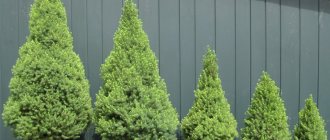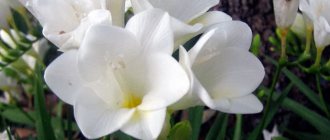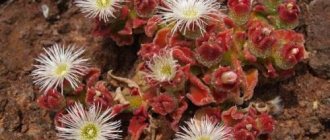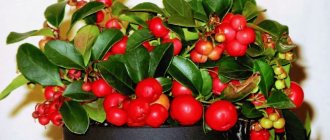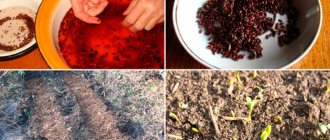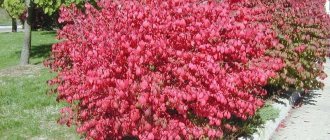Feijoa is native to South America. The plant inherited its unusual name from the Brazilian naturalist Feijo, who was the first to curb the wild nature of this shrub and make it affectionate and domestic. The closest relative of feijoa is the well-known, very beautiful, but not edible myrtle, from which the family to which feijoa (myrtaceae) belongs comes.
This plant is grown not only in home (apartment) conditions, but also, if desired, in normally heated industrial premises (this is for lovers of indoor plants at work), the plant is quite unpretentious, easily tolerates ventilation and not very cold drafts.
A little about the plant
Feijoa fruits are green with a light waxy coating. When they ripen, they become slightly yellowish. As for the taste, it is traditionally considered to be pineapple-strawberry, as for me, but rather the taste of feijoa is more reminiscent of slightly greenish gooseberries. But the fact that feijoa fruits contain soluble iodine compounds is an indisputable and proven fact, for which they are very highly valued. Their shape can be different: ovoid, round, oval, it depends on the variety. They vary in size and weight: from 20-40 to 100 g and more. When picked unripe, they ripen well.
Feijoa flowers are quite large, reaching a diameter of 3-3.5 cm, on long stalks, in appearance they are somewhat reminiscent of fuchsia flowers. They have a pleasant aroma. The outer side of the petals is white, the inner side is pinkish-scarlet with yellow anthers and protruding pink stamens. The pistils are elongated, dark red in color with white stigmas.
The leaves are quite dense, oval, green on the outside, with a shiny surface, while the lower part of the leaf is silver-gray, slightly pubescent. Let’s finish this boring botanical description and move on to practice.
Feijoa or acca (Assa sellowiana)
This plant belongs to the myrtle family (Myrtaceae).
The plant is named after the Brazilian botanist de Silva Feijo, who was the first to draw attention to this unusual fruit crop. Feyhodsha comes from South America, where it is still found in the forests of this continent. For indoor cultivation, what is primarily important, of course, is not fruiting, but decorative qualities, and feijoa has them: gray-green foliage on top and silvery below, bright crimson-white flowers. By the way, their fleshy petals have a pleasant sour taste. In terms of frost resistance, this plant is significantly superior to citrus fruits and can safely tolerate temperatures down to minus 10 degrees Celsius.
Feijoa fruits contain water-soluble and easily digestible iodine compounds. They are used to prevent and treat cardiovascular diseases. In addition, they have pronounced bactericidal properties and have a detrimental effect on Staphylococcus aureus and Escherichia coli. Feijoa fruits are consumed fresh and in preparations (compotes, preserves, jams). In terms of vitamin C content, they are close to citrus fruits.
One type of f. is used in fruit growing. Zellova. It is a low-growing shrub or spreading tree, three to five meters high.
Feijoa blooms on the shoots of the current year. The fruits are green berries (oblong, bumpy surface). Their sizes depend on the variety and weigh on average 30-40 g, but sometimes reach 120 g. The taste of feijoa is reminiscent of a mixture of pineapple and strawberries.
Recommendations for growing Feijoa at home
In indoor conditions, this crop can be propagated both by seeds and vegetatively (by cuttings).
The first method is accessible and not labor-intensive. You just need to have ripe fruits. You should not take overripe ones or those that have been stored for a long time, as the seeds in them sometimes turn out to be sprouted and are injured when removed.
Using a sharp knife, cut off approximately a fifth of the fruit from the stalk side and gently squeeze out the jelly-like mass with your fingers. Then, in a weak solution of potassium permanganate, the seeds are cleared of sticky pulp, washed and dried.
Sow in January-February in shallow ditches, covering with soil at ? centimeter The substrate is light, air- and water-permeable; you can use a mixture of leaf soil, high-moor peat and river sand (2:2:1). Crops should be moistened with a sprayer; it is not recommended to use a watering can so as not to erode the soil. The cuvette is placed on the windowsill and kept at +16+19 degrees C, without additional lighting. Shoots may appear no earlier than in two weeks.
After the young seedlings have developed four pairs of true leaves, they can be planted in separate pots. The substrate should be heavier: turf, leaf soil, humus and river sand (6:4:1:1).
Cuttings are used to preserve varietal qualities. Semi-lignified shoots with 2-3 nodes, approximately eight to ten centimeters long, are cut from the middle part of the crown. To avoid moisture loss, leave only one pair of leaves on the cutting.
You can root cuttings in simple clay pots, tightly filled with a mixture of leaf soil and river sand in equal parts. The cuttings are deepened into the substrate by 1/3 of their length in an inclined position. Then the soil is generously spilled with a warm (28-30%) solution of pink potassium permanganate and, if desired, a solution of heteroauxin (1/4 tablet per 0.5 liter of water). A prerequisite for successful rooting is high air humidity and heating the substrate to +25+30 degrees C. The cuttings are covered with plastic bags or glass jars.
Roots form in 1.5-2 months, depending on the temperature of the substrate and lighting, which should be intense. However, cuttings should be protected from direct sunlight. Periodically, the cover is removed for ventilation, after which it is useful to sprinkle the plants with water again. Rooted cuttings are transplanted into pots with the same soil composition as for seedlings.
There are two more methods of vegetative propagation: grafting and separation of the resulting shoots. The grafting is practically not used due to the poor survival rate of the eyes during budding.
The method of air layering of fruit-bearing plants gives good results. To do this, in March-April, cuts are made on the undersides of annual branches, these places are wrapped in wet sphagnum moss, wrapped in plastic wrap and tied tightly to retain moisture longer. After the roots form (1.5-2 months), the branch is separated and planted in a substrate.
Young Feijoa plants need to be replanted once a year into a larger container, adding fresh soil mixture. Adult specimens need replanting after 4-5 years. In this case, under no circumstances should you destroy the earthen ball on the roots. Fill the free spaces with the substrate and compact it well along the edges of the walls of the pot. If the roots have to be cut, then the branches should be shortened by 1/3.
As soon as the plant reaches 25-30 cm in height, it is cut to 2/3. This promotes better development of side shoots. In order for Feijoa to quickly enter the fruiting phase, the tree is formed on a low trunk. Young shoots appearing at the root collar are cut out or planted. Remove weak or dried branches.
Reproduction
Feijoa propagation occurs by layering, cuttings and seeds.
Propagation by seeds
Seeds can be sown from January to March to a depth of no more than 1/2 cm. At a constant room temperature of +20-25 degrees, seedlings will appear within half a month. It should be remembered that when a plant is propagated by seeds, the varietal characteristics of feijoa are not always preserved. Only self-fertile plants retain varietal characteristics. Therefore, it is advisable to leave several plants for cultivation, so that later you can compare their taste. Varietal seedlings can be obtained from root suckers, layering, green cuttings and through grafting.
Propagation by cuttings
Subsequently, feijoa can be propagated by cuttings. To do this, semi-lignified branches about 15 cm long, with 2-3 leaves, should be soaked in a solution of root or heteroauxin for 17 hours from October to December. Myrtle tree cuttings do not take root well, so this procedure is necessary. Meanwhile, adult plants form a large amount of root shoots, which are removed to improve fruiting, and it can be used for propagation.
Feijoa fruiting begins in the fifth year. Fruit ripening begins in October and continues until winter. Each feijoa bush can produce from 5 to 30 kg of fruit. Fruits developing from a late ovary are not marketable.
Watering
It should be watered quite generously. Overdrying of the earthen clod leads to the shedding of leaves, the death of branches and part of the root system. After watering, there is no need to drain the water that has flowed out of the pot into the pan, since after some time it will be absorbed into the earthen lump. In winter, when air humidity drops sharply, it is useful to spray the plants with lukewarm water more often.
Feijoa is undemanding to the soil, but do not forget to take into account that in a limited volume the fertility of the soil is quickly depleted, and the plant needs additional nutrition. Feed it in the same way as other fruit crops growing in the house.
Once every half month, you can alternately add horse manure (1:10), superphosphate (one teaspoon per two liters of water) and a week-old ash extract (one tablespoon of hardwood wood ash per liter of water). Before this, the soil should be thoroughly moistened. In winter, continue to feed in the same way as in summer.
Feijoa is a cross-pollinated plant. To get a harvest, you must have at least 2 copies. At home, it is quite difficult to achieve their simultaneous flowering, so it is better to purchase parthenocarnic (self-pollinating) varieties. These include, for example, “Crimean Early” and “Nikitsky Aromatny”. There are also foreign varieties that have proven themselves well in rooms. Seedlings bear fruit in the fifth or sixth year, and rooted cuttings bloom after 3.5 years. Fruits ripened indoors are in no way inferior to those grown in open ground.
Useful properties and contraindications
All feijoa fruits have many beneficial properties, which is why it is actively used in dietary nutrition. But you shouldn’t get carried away with them - they also have restrictions and contraindications for use. All these points are worth considering in more detail.
The benefit of feijoa lies in the fact that it contains a large amount of iodine - a handful of these berries covers the body's daily need for this element, preventing the development of problems with the thyroid gland. Along with iodine, the fruits of the aromatic green berry also contain large quantities of many vitamins - vitamin C, as well as vitamins B and PP.
Due to the easily absorbed proteins and fats, these green berries are indicated for vitamin deficiency and loss of strength - to restore the supply of vitamins and give strength, you should eat 5 fruits daily. Among other things, the peel of this aromatic fruit contains powerful natural antioxidants - they prevent early aging and protect against the negative effects of external factors.
Despite all its benefits, feijoa has restrictions and contraindications for consumption:
- Due to its high sugar content, it is contraindicated for anyone diagnosed with diabetes.
- This berry does not go well with fermented milk products - if you drink it with kefir or milk, the gastrointestinal tract will react with upset.
- You should not give this exotic berry, like any imported fruit, to children under one year old - the child has not yet developed the enzymes to process it, which can provoke negative consequences.
- Pregnant women should also consume the berry - an overdose of iodine, like its deficiency, can also be harmful and a threat to the mother and child.
The benefits and harms of feijoa for each individual person are relative, it is important to follow the main rule - do not get carried away, even if there are no contraindications, remember that even vitamins become dangerous if you are overindulged in them. About growing feijoa at home in the video:
About growing feijoa at home in the video:
Plant protection
To grow Feijoa, the plant requires protection. From time to time, feijoas have to be protected from pests, most often from spider mites and false scale insects. The first mainly damages young shoots.
Good results in the fight against it are obtained by spraying plants with a solution of keltan (two grams per liter of water). The best time for spraying is evening. Sometimes one treatment is enough, but it is safer to repeat it after a week.
It is more difficult to fight false scale insects. It settles on the upper, glossy side of the leaf along the main vein. True, it does not reproduce as quickly as a tick.
Dear reader, if you still haven’t decided to grow Feijoa in your home, but really love this berry, watch the video, which gives recommendations on how to make the right choice when buying the fruit of this plant.
Seed extraction
We separate part of the pulp with seeds from the fruit. Small seeds are separated from the pulp very poorly, so add a little water to the pulp and leave it all for a few days so that it all ferments slightly. Then the seeds will easily separate from the pulp. They need to be washed and dried. This planting material will have good germination for three years.


